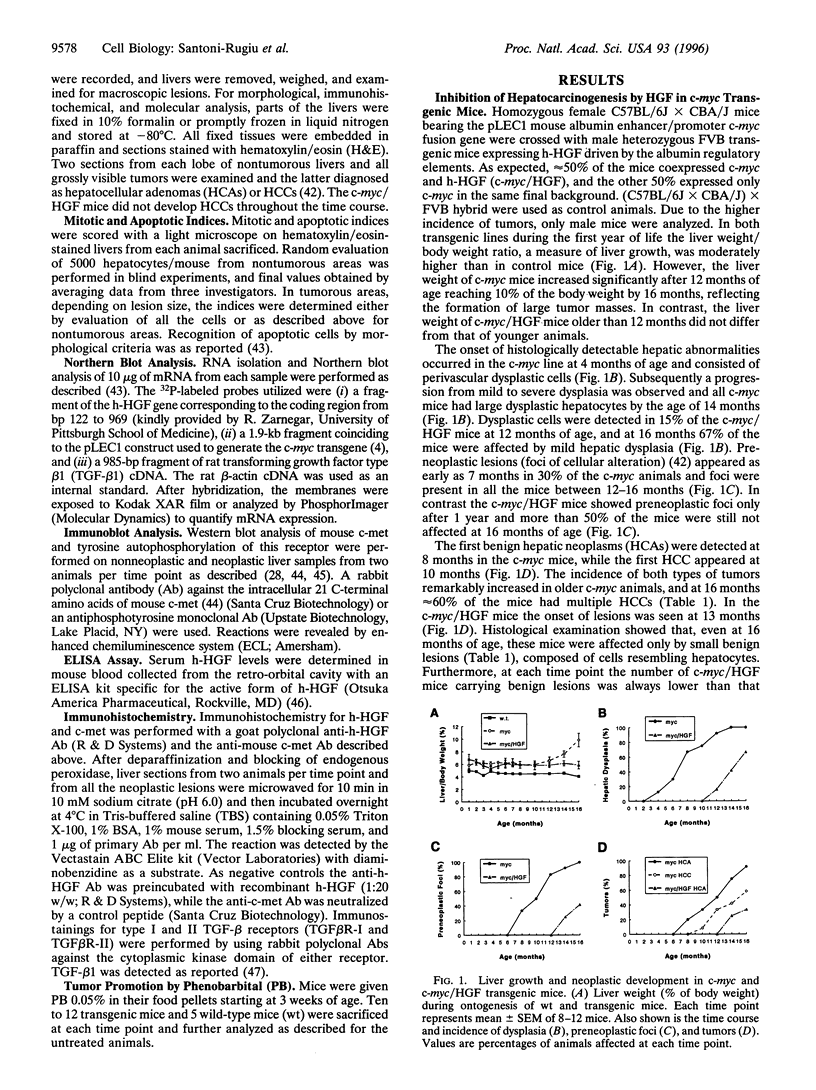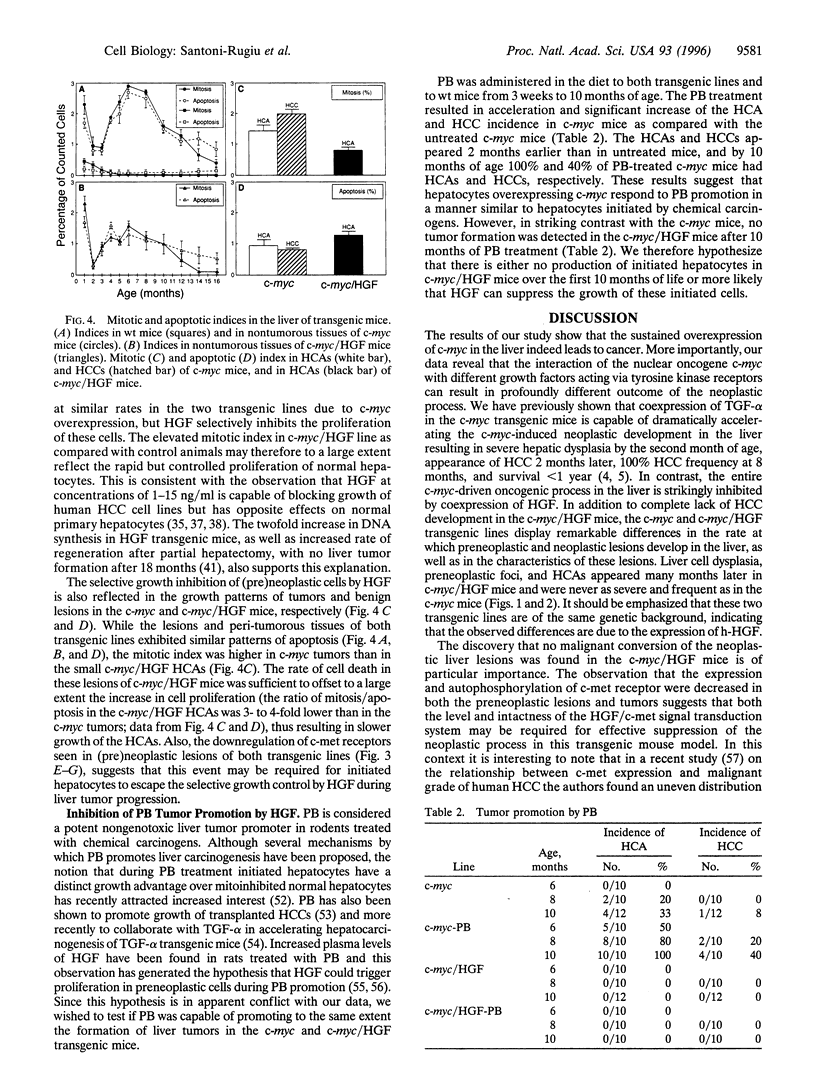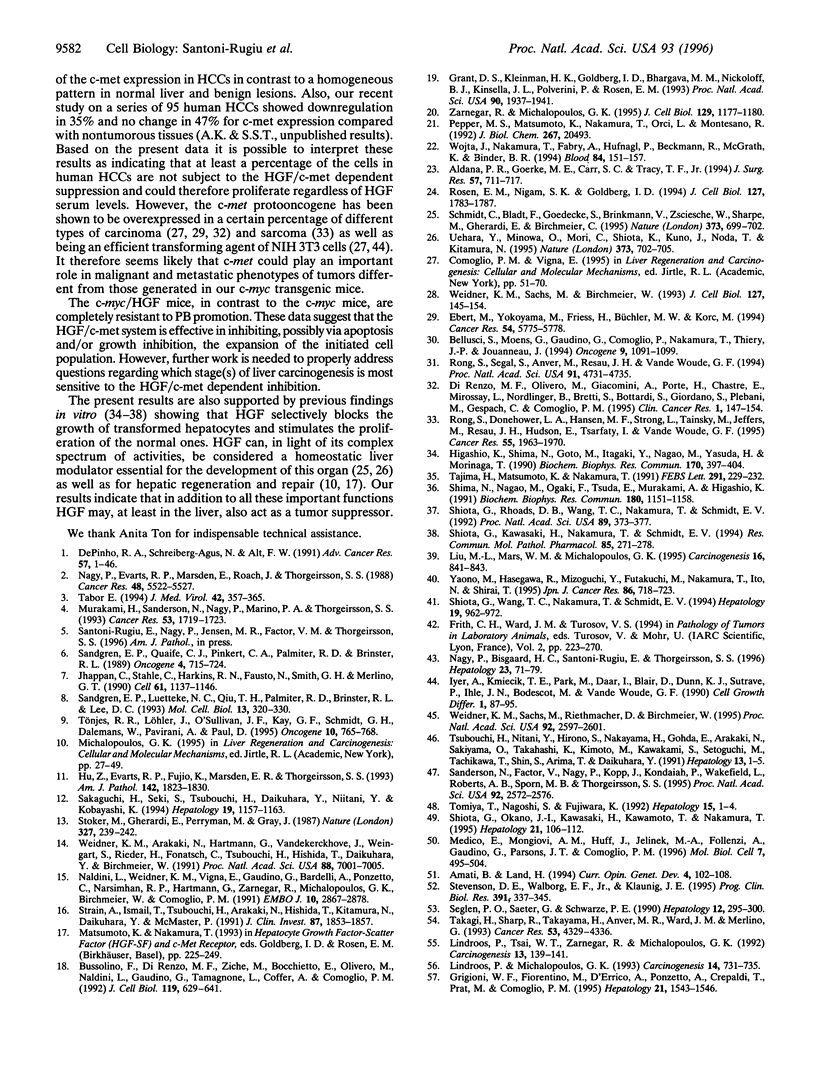Abstract
Overexpression of the c-myc oncogene is associated with a variety of both human and experimental tumors, and cooperation of other oncogenes and growth factors with the myc family are critical in the evolution of the malignant phenotype. The interaction of hepatocyte growth factor (HGF) with c-myc during hepatocarcinogenesis in a transgenic mouse model has been analyzed. While sustained overexpression of c-myc in the liver leads to cancer, coexpression of HGF and c-myc in the liver delayed the appearance of preneoplastic lesions and prevented malignant conversion. Furthermore, tumor promotion by phenobarbital was completely inhibited in the c-myc/HGF double transgenic mice, whereas phenobarbital was an effective tumor promoter in the c-myc single transgenic mice. The results indicate that HGF may function as a tumor suppressor during early stages of liver carcinogenesis, and suggest the possibility of therapeutic application for this cytokine.
Full text
PDF





Images in this article
Selected References
These references are in PubMed. This may not be the complete list of references from this article.
- Aldana P. R., Goerke M. E., Carr S. C., Tracy T. F., Jr The expression of regenerative growth factors in chronic liver injury and repair. J Surg Res. 1994 Dec;57(6):711–717. doi: 10.1006/jsre.1994.1206. [DOI] [PubMed] [Google Scholar]
- Amati B., Land H. Myc-Max-Mad: a transcription factor network controlling cell cycle progression, differentiation and death. Curr Opin Genet Dev. 1994 Feb;4(1):102–108. doi: 10.1016/0959-437x(94)90098-1. [DOI] [PubMed] [Google Scholar]
- Bellusci S., Moens G., Gaudino G., Comoglio P., Nakamura T., Thiery J. P., Jouanneau J. Creation of an hepatocyte growth factor/scatter factor autocrine loop in carcinoma cells induces invasive properties associated with increased tumorigenicity. Oncogene. 1994 Apr;9(4):1091–1099. [PubMed] [Google Scholar]
- Bussolino F., Di Renzo M. F., Ziche M., Bocchietto E., Olivero M., Naldini L., Gaudino G., Tamagnone L., Coffer A., Comoglio P. M. Hepatocyte growth factor is a potent angiogenic factor which stimulates endothelial cell motility and growth. J Cell Biol. 1992 Nov;119(3):629–641. doi: 10.1083/jcb.119.3.629. [DOI] [PMC free article] [PubMed] [Google Scholar]
- DePinho R. A., Schreiber-Agus N., Alt F. W. myc family oncogenes in the development of normal and neoplastic cells. Adv Cancer Res. 1991;57:1–46. doi: 10.1016/s0065-230x(08)60994-x. [DOI] [PubMed] [Google Scholar]
- Di Renzo M. F., Olivero M., Giacomini A., Porte H., Chastre E., Mirossay L., Nordlinger B., Bretti S., Bottardi S., Giordano S. Overexpression and amplification of the met/HGF receptor gene during the progression of colorectal cancer. Clin Cancer Res. 1995 Feb;1(2):147–154. [PubMed] [Google Scholar]
- Ebert M., Yokoyama M., Friess H., Büchler M. W., Korc M. Coexpression of the c-met proto-oncogene and hepatocyte growth factor in human pancreatic cancer. Cancer Res. 1994 Nov 15;54(22):5775–5778. [PubMed] [Google Scholar]
- Grant D. S., Kleinman H. K., Goldberg I. D., Bhargava M. M., Nickoloff B. J., Kinsella J. L., Polverini P., Rosen E. M. Scatter factor induces blood vessel formation in vivo. Proc Natl Acad Sci U S A. 1993 Mar 1;90(5):1937–1941. doi: 10.1073/pnas.90.5.1937. [DOI] [PMC free article] [PubMed] [Google Scholar]
- Grigioni W. F., Fiorentino M., D'Errico A., Ponzetto A., Crepaldi T., Prat M., Comoglio P. M. Overexpression of c-met protooncogene product and raised Ki67 index in hepatocellular carcinomas with respect to benign liver conditions. Hepatology. 1995 Jun;21(6):1543–1546. [PubMed] [Google Scholar]
- Higashio K., Shima N., Goto M., Itagaki Y., Nagao M., Yasuda H., Morinaga T. Identity of a tumor cytotoxic factor from human fibroblasts and hepatocyte growth factor. Biochem Biophys Res Commun. 1990 Jul 16;170(1):397–404. doi: 10.1016/0006-291x(90)91287-3. [DOI] [PubMed] [Google Scholar]
- Hu Z., Evarts R. P., Fujio K., Marsden E. R., Thorgeirsson S. S. Expression of hepatocyte growth factor and c-met genes during hepatic differentiation and liver development in the rat. Am J Pathol. 1993 Jun;142(6):1823–1830. [PMC free article] [PubMed] [Google Scholar]
- Iyer A., Kmiecik T. E., Park M., Daar I., Blair D., Dunn K. J., Sutrave P., Ihle J. N., Bodescot M., Vande Woude G. F. Structure, tissue-specific expression, and transforming activity of the mouse met protooncogene. Cell Growth Differ. 1990 Feb;1(2):87–95. [PubMed] [Google Scholar]
- Jhappan C., Stahle C., Harkins R. N., Fausto N., Smith G. H., Merlino G. T. TGF alpha overexpression in transgenic mice induces liver neoplasia and abnormal development of the mammary gland and pancreas. Cell. 1990 Jun 15;61(6):1137–1146. doi: 10.1016/0092-8674(90)90076-q. [DOI] [PubMed] [Google Scholar]
- Lindroos P., Michalopoulos G. K. Response of phenobarbital- and ciprofibrate-exposed hepatocytes to growth factors in type I collagen gels. Carcinogenesis. 1993 Apr;14(4):731–735. doi: 10.1093/carcin/14.4.731. [DOI] [PubMed] [Google Scholar]
- Lindroos P., Tsai W. H., Zarnegar R., Michalopoulos G. K. Plasma levels of HGF in rats treated with tumor promoters. Carcinogenesis. 1992 Jan;13(1):139–141. doi: 10.1093/carcin/13.1.139. [DOI] [PubMed] [Google Scholar]
- Liu M. L., Mars W. M., Michalopoulos G. K. Hepatocyte growth factor inhibits cell proliferation in vivo of rat hepatocellular carcinomas induced by diethylnitrosamine. Carcinogenesis. 1995 Apr;16(4):841–843. doi: 10.1093/carcin/16.4.841. [DOI] [PubMed] [Google Scholar]
- Medico E., Mongiovi A. M., Huff J., Jelinek M. A., Follenzi A., Gaudino G., Parsons J. T., Comoglio P. M. The tyrosine kinase receptors Ron and Sea control "scattering" and morphogenesis of liver progenitor cells in vitro. Mol Biol Cell. 1996 Apr;7(4):495–504. doi: 10.1091/mbc.7.4.495. [DOI] [PMC free article] [PubMed] [Google Scholar]
- Murakami H., Sanderson N. D., Nagy P., Marino P. A., Merlino G., Thorgeirsson S. S. Transgenic mouse model for synergistic effects of nuclear oncogenes and growth factors in tumorigenesis: interaction of c-myc and transforming growth factor alpha in hepatic oncogenesis. Cancer Res. 1993 Apr 15;53(8):1719–1723. [PubMed] [Google Scholar]
- Nagy P., Bisgaard H. C., Santoni-Rugiu E., Thorgeirsson S. S. In vivo infusion of growth factors enhances the mitogenic response of rat hepatic ductal (oval) cells after administration of 2-acetylaminofluorene. Hepatology. 1996 Jan;23(1):71–79. doi: 10.1002/hep.510230111. [DOI] [PubMed] [Google Scholar]
- Nagy P., Evarts R. P., Marsden E., Roach J., Thorgeirsson S. S. Cellular distribution of c-myc transcripts during chemical hepatocarcinogenesis in rats. Cancer Res. 1988 Oct 1;48(19):5522–5527. [PubMed] [Google Scholar]
- Naldini L., Weidner K. M., Vigna E., Gaudino G., Bardelli A., Ponzetto C., Narsimhan R. P., Hartmann G., Zarnegar R., Michalopoulos G. K. Scatter factor and hepatocyte growth factor are indistinguishable ligands for the MET receptor. EMBO J. 1991 Oct;10(10):2867–2878. doi: 10.1002/j.1460-2075.1991.tb07836.x. [DOI] [PMC free article] [PubMed] [Google Scholar]
- Pepper M. S., Matsumoto K., Nakamura T., Orci L., Montesano R. Hepatocyte growth factor increases urokinase-type plasminogen activator (u-PA) and u-PA receptor expression in Madin-Darby canine kidney epithelial cells. J Biol Chem. 1992 Oct 5;267(28):20493–20496. [PubMed] [Google Scholar]
- Rong S., Donehower L. A., Hansen M. F., Strong L., Tainsky M., Jeffers M., Resau J. H., Hudson E., Tsarfaty I., Vande Woude G. F. Met proto-oncogene product is overexpressed in tumors of p53-deficient mice and tumors of Li-Fraumeni patients. Cancer Res. 1995 May 1;55(9):1963–1970. [PubMed] [Google Scholar]
- Rong S., Segal S., Anver M., Resau J. H., Vande Woude G. F. Invasiveness and metastasis of NIH 3T3 cells induced by Met-hepatocyte growth factor/scatter factor autocrine stimulation. Proc Natl Acad Sci U S A. 1994 May 24;91(11):4731–4735. doi: 10.1073/pnas.91.11.4731. [DOI] [PMC free article] [PubMed] [Google Scholar]
- Rosen E. M., Nigam S. K., Goldberg I. D. Scatter factor and the c-met receptor: a paradigm for mesenchymal/epithelial interaction. J Cell Biol. 1994 Dec;127(6 Pt 2):1783–1787. doi: 10.1083/jcb.127.6.1783. [DOI] [PMC free article] [PubMed] [Google Scholar]
- Sakaguchi H., Seki S., Tsubouchi H., Daikuhara Y., Niitani Y., Kobayashi K. Ultrastructural location of human hepatocyte growth factor in human liver. Hepatology. 1994 May;19(5):1157–1163. [PubMed] [Google Scholar]
- Sanderson N., Factor V., Nagy P., Kopp J., Kondaiah P., Wakefield L., Roberts A. B., Sporn M. B., Thorgeirsson S. S. Hepatic expression of mature transforming growth factor beta 1 in transgenic mice results in multiple tissue lesions. Proc Natl Acad Sci U S A. 1995 Mar 28;92(7):2572–2576. doi: 10.1073/pnas.92.7.2572. [DOI] [PMC free article] [PubMed] [Google Scholar]
- Sandgren E. P., Luetteke N. C., Qiu T. H., Palmiter R. D., Brinster R. L., Lee D. C. Transforming growth factor alpha dramatically enhances oncogene-induced carcinogenesis in transgenic mouse pancreas and liver. Mol Cell Biol. 1993 Jan;13(1):320–330. doi: 10.1128/mcb.13.1.320. [DOI] [PMC free article] [PubMed] [Google Scholar]
- Sandgren E. P., Quaife C. J., Pinkert C. A., Palmiter R. D., Brinster R. L. Oncogene-induced liver neoplasia in transgenic mice. Oncogene. 1989 Jun;4(6):715–724. [PubMed] [Google Scholar]
- Schmidt C., Bladt F., Goedecke S., Brinkmann V., Zschiesche W., Sharpe M., Gherardi E., Birchmeier C. Scatter factor/hepatocyte growth factor is essential for liver development. Nature. 1995 Feb 23;373(6516):699–702. doi: 10.1038/373699a0. [DOI] [PubMed] [Google Scholar]
- Seglen P. O., Saeter G., Schwarze P. E. Liver tumor promoters stimulate growth of transplanted hepatocellular carcinomas. Hepatology. 1990 Aug;12(2):295–300. doi: 10.1002/hep.1840120217. [DOI] [PubMed] [Google Scholar]
- Shima N., Nagao M., Ogaki F., Tsuda E., Murakami A., Higashio K. Tumor cytotoxic factor/hepatocyte growth factor from human fibroblasts: cloning of its cDNA, purification and characterization of recombinant protein. Biochem Biophys Res Commun. 1991 Oct 31;180(2):1151–1158. doi: 10.1016/s0006-291x(05)81187-8. [DOI] [PubMed] [Google Scholar]
- Shiota G., Kawasaki H., Nakamura T., Schmidt E. V. Inhibitory effect of hepatocyte growth factor against FaO hepatocellular carcinoma cells may be associated with changes of intracellular signalling pathways mediated by protein kinase C. Res Commun Mol Pathol Pharmacol. 1994 Sep;85(3):271–278. [PubMed] [Google Scholar]
- Shiota G., Okano J., Kawasaki H., Kawamoto T., Nakamura T. Serum hepatocyte growth factor levels in liver diseases: clinical implications. Hepatology. 1995 Jan;21(1):106–112. [PubMed] [Google Scholar]
- Shiota G., Rhoads D. B., Wang T. C., Nakamura T., Schmidt E. V. Hepatocyte growth factor inhibits growth of hepatocellular carcinoma cells. Proc Natl Acad Sci U S A. 1992 Jan 1;89(1):373–377. doi: 10.1073/pnas.89.1.373. [DOI] [PMC free article] [PubMed] [Google Scholar]
- Shiota G., Wang T. C., Nakamura T., Schmidt E. V. Hepatocyte growth factor in transgenic mice: effects on hepatocyte growth, liver regeneration and gene expression. Hepatology. 1994 Apr;19(4):962–972. [PubMed] [Google Scholar]
- Stevenson D. E., Walborg E. F., Jr, Klaunig J. E. The species specificity of dieldrin- or phenobarbital- induced hepatocarcinogenesis: case studies with implications for human health risk assessment. Prog Clin Biol Res. 1995;391:337–345. [PubMed] [Google Scholar]
- Stoker M., Gherardi E., Perryman M., Gray J. Scatter factor is a fibroblast-derived modulator of epithelial cell mobility. Nature. 1987 May 21;327(6119):239–242. doi: 10.1038/327239a0. [DOI] [PubMed] [Google Scholar]
- Strain A. J., Ismail T., Tsubouchi H., Arakaki N., Hishida T., Kitamura N., Daikuhara Y., McMaster P. Native and recombinant human hepatocyte growth factors are highly potent promoters of DNA synthesis in both human and rat hepatocytes. J Clin Invest. 1991 May;87(5):1853–1857. doi: 10.1172/JCI115207. [DOI] [PMC free article] [PubMed] [Google Scholar]
- Tabor E. Tumor suppressor genes, growth factor genes, and oncogenes in hepatitis B virus-associated hepatocellular carcinoma. J Med Virol. 1994 Apr;42(4):357–365. doi: 10.1002/jmv.1890420406. [DOI] [PubMed] [Google Scholar]
- Tajima H., Matsumoto K., Nakamura T. Hepatocyte growth factor has potent anti-proliferative activity in various tumor cell lines. FEBS Lett. 1991 Oct 21;291(2):229–232. doi: 10.1016/0014-5793(91)81291-f. [DOI] [PubMed] [Google Scholar]
- Takagi H., Sharp R., Takayama H., Anver M. R., Ward J. M., Merlino G. Collaboration between growth factors and diverse chemical carcinogens in hepatocarcinogenesis of transforming growth factor alpha transgenic mice. Cancer Res. 1993 Sep 15;53(18):4329–4336. [PubMed] [Google Scholar]
- Tomiya T., Nagoshi S., Fujiwara K. Significance of serum human hepatocyte growth factor levels in patients with hepatic failure. Hepatology. 1992 Jan;15(1):1–4. doi: 10.1002/hep.1840150102. [DOI] [PubMed] [Google Scholar]
- Tsubouchi H., Niitani Y., Hirono S., Nakayama H., Gohda E., Arakaki N., Sakiyama O., Takahashi K., Kimoto M., Kawakami S. Levels of the human hepatocyte growth factor in serum of patients with various liver diseases determined by an enzyme-linked immunosorbent assay. Hepatology. 1991 Jan;13(1):1–5. [PubMed] [Google Scholar]
- Tönjes R. R., Löhler J., O'Sullivan J. F., Kay G. F., Schmidt G. H., Dalemans W., Pavirani A., Paul D. Autocrine mitogen IgEGF cooperates with c-myc or with the Hcs locus during hepatocarcinogenesis in transgenic mice. Oncogene. 1995 Feb 16;10(4):765–768. [PubMed] [Google Scholar]
- Uehara Y., Minowa O., Mori C., Shiota K., Kuno J., Noda T., Kitamura N. Placental defect and embryonic lethality in mice lacking hepatocyte growth factor/scatter factor. Nature. 1995 Feb 23;373(6516):702–705. doi: 10.1038/373702a0. [DOI] [PubMed] [Google Scholar]
- Weidner K. M., Arakaki N., Hartmann G., Vandekerckhove J., Weingart S., Rieder H., Fonatsch C., Tsubouchi H., Hishida T., Daikuhara Y. Evidence for the identity of human scatter factor and human hepatocyte growth factor. Proc Natl Acad Sci U S A. 1991 Aug 15;88(16):7001–7005. doi: 10.1073/pnas.88.16.7001. [DOI] [PMC free article] [PubMed] [Google Scholar]
- Weidner K. M., Sachs M., Birchmeier W. The Met receptor tyrosine kinase transduces motility, proliferation, and morphogenic signals of scatter factor/hepatocyte growth factor in epithelial cells. J Cell Biol. 1993 Apr;121(1):145–154. doi: 10.1083/jcb.121.1.145. [DOI] [PMC free article] [PubMed] [Google Scholar]
- Weidner K. M., Sachs M., Riethmacher D., Birchmeier W. Mutation of juxtamembrane tyrosine residue 1001 suppresses loss-of-function mutations of the met receptor in epithelial cells. Proc Natl Acad Sci U S A. 1995 Mar 28;92(7):2597–2601. doi: 10.1073/pnas.92.7.2597. [DOI] [PMC free article] [PubMed] [Google Scholar]
- Wojta J., Nakamura T., Fabry A., Hufnagl P., Beckmann R., McGrath K., Binder B. R. Hepatocyte growth factor stimulates expression of plasminogen activator inhibitor type 1 and tissue factor in HepG2 cells. Blood. 1994 Jul 1;84(1):151–157. [PubMed] [Google Scholar]
- Yaono M., Hasegawa R., Mizoguchi Y., Futakuchi M., Nakamura T., Ito N., Shirai T. Hepatocyte growth factor enhancement of preneoplastic hepatic foci development in rats treated with diethylnitrosamine and N-ethyl-N-hydroxyethylnitrosamine. Jpn J Cancer Res. 1995 Aug;86(8):718–723. doi: 10.1111/j.1349-7006.1995.tb02459.x. [DOI] [PMC free article] [PubMed] [Google Scholar]
- Zarnegar R., Michalopoulos G. K. The many faces of hepatocyte growth factor: from hepatopoiesis to hematopoiesis. J Cell Biol. 1995 Jun;129(5):1177–1180. doi: 10.1083/jcb.129.5.1177. [DOI] [PMC free article] [PubMed] [Google Scholar]




